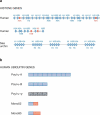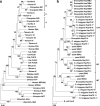Concerted and birth-and-death evolution of multigene families
- PMID: 16285855
- PMCID: PMC1464479
- DOI: 10.1146/annurev.genet.39.073003.112240
Concerted and birth-and-death evolution of multigene families
Abstract
Until around 1990, most multigene families were thought to be subject to concerted evolution, in which all member genes of a family evolve as a unit in concert. However, phylogenetic analysis of MHC and other immune system genes showed a quite different evolutionary pattern, and a new model called birth-and-death evolution was proposed. In this model, new genes are created by gene duplication and some duplicate genes stay in the genome for a long time, whereas others are inactivated or deleted from the genome. Later investigations have shown that most non-rRNA genes including highly conserved histone or ubiquitin genes are subject to this type of evolution. However, the controversy over the two models is still continuing because the distinction between the two models becomes difficult when sequence differences are small. Unlike concerted evolution, the model of birth-and-death evolution can give some insights into the origins of new genetic systems or new phenotypic characters.
Figures






References
-
- Andersson L, Gustafsson K, Jonsson AK, Rask L. Concerted evolution in a segment of the first domain exon of polymorphic MHC class II beta loci. Immunogenetics. 1991;33:235–42. - PubMed
-
- Annilo T, Dean M. Degeneration of an ATP-binding cassette transporter gene, ABCC13, in different mammalian lineages. Genomics. 2004;84:34–46. - PubMed
Publication types
MeSH terms
Grants and funding
LinkOut - more resources
Full Text Sources
Research Materials

